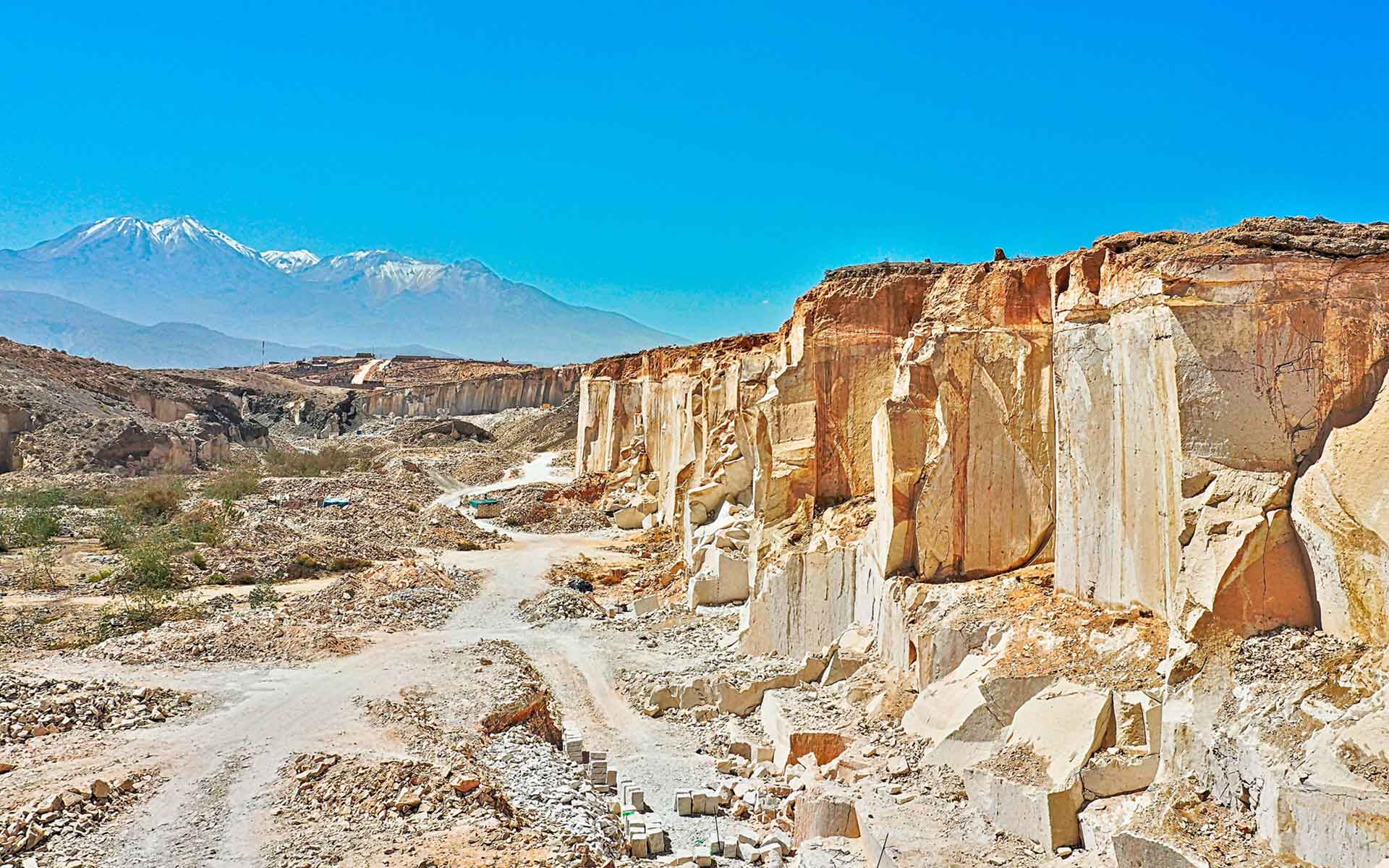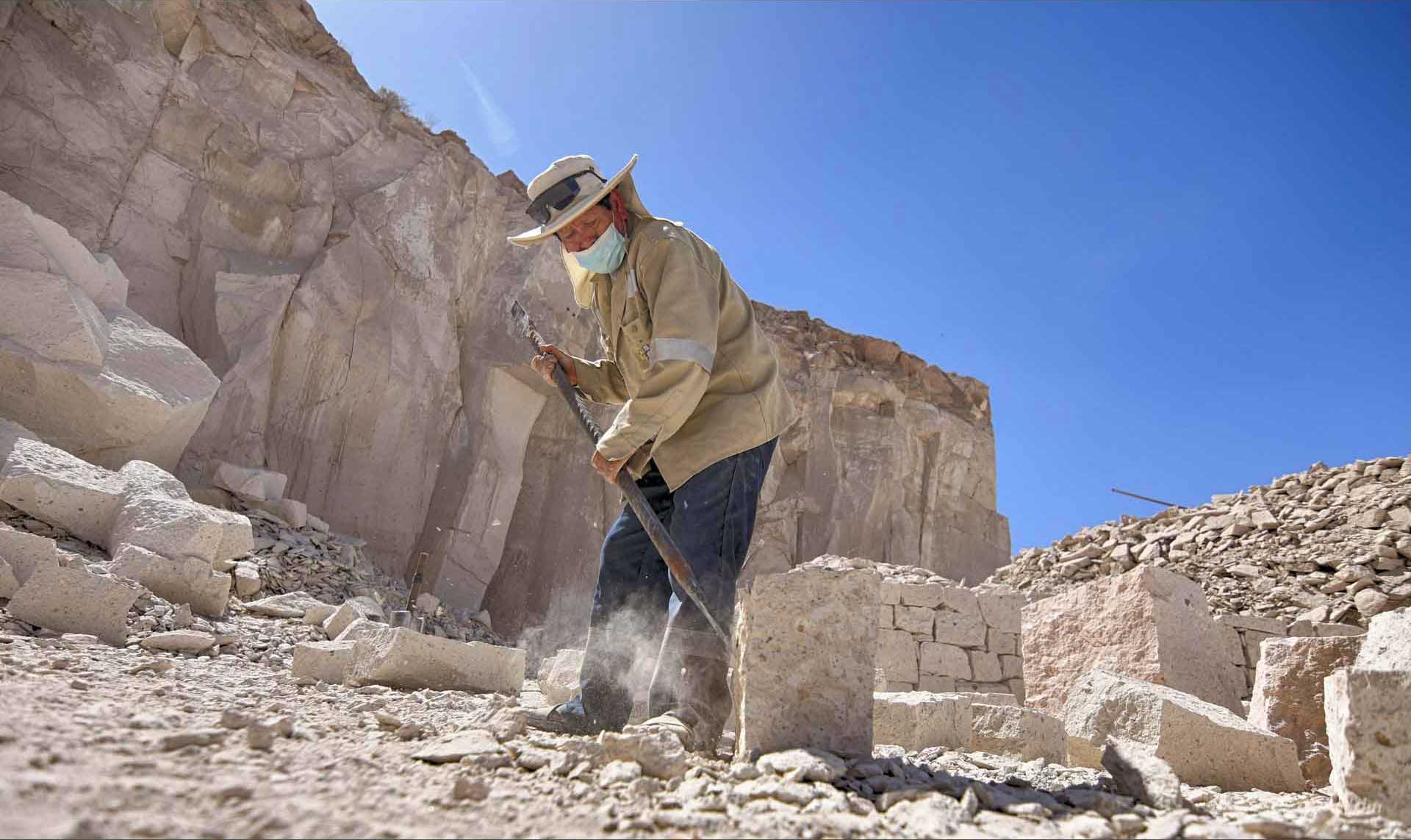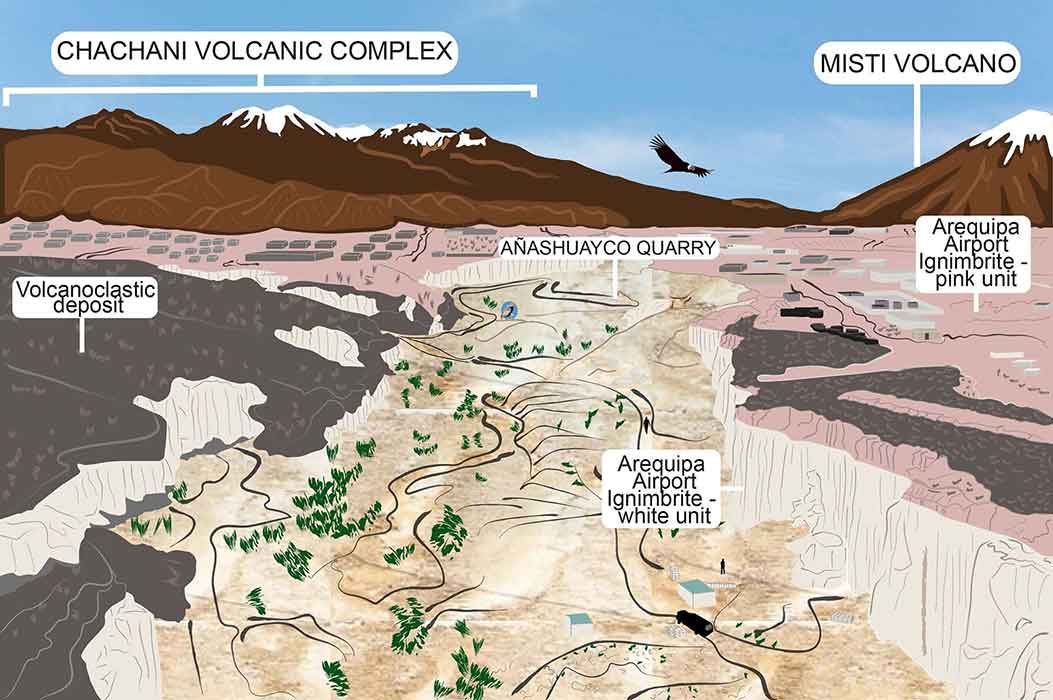The vapor phase ignimbrites of Sillar in the Añashuayco Quarries of Arequipa
PERU

View of the left bank of the “Añashuayco quarry” where the Arequipa Airport ignimbrite is seen with white unit and pink unit.
Geological Period
Pleistocene / Calabrian
Main geological interest
Volcanology
Igneous and metamorphic petrology
Location
The Añashuayco quarries, South America.
16°21’35.0″S, 71°36’23.0″W
View of the left bank of the “Añashuayco quarry” where the Arequipa Airport ignimbrite is seen with white unit and pink unit.
The global type locality for ‘sillar’ vapor phase ignimbrite, formed by a large explosive eruption 1.65 ma ago in southern Peru.
The Añashuayco quarry is the global type locality for vapor phase ignimbrites, providing this important facies with its name, ‘Sillar’. The Añashuayco quarry is also a globally recognized site connected to the UNESCO World Heritage designation for Arequipa, and for Peruvian intangible heritage. The Añashuayco sillar quarry is a global site for the communication, through geoheritage, of the origin of ignimbrite and carries a vital global and local message about natural hazards and community resilience. It is a perfect site to showcase science working for, and within, society.
- Geological description
Sillar is a specific type of ignimbrite deposit, where hot gasses alter and cement the pumice into a strong coherent mass. It was first described in what is today called the Arequipa Airport Ignimbrite by (Hatch, 1885-1886) and fully described by Fenner (1948). The Ignimbrite represents a large caldera forming eruption, dated at c. 1.65 Ma (Paquereau-Lebti et al., 2006), generating pyroclastic density currents that filled the Arequipa tectonic depression which is a pull-apart basin. This ignimbrite is divided into a lower white and compact unit covered by an upper unconsolidated pink unit. The composition of magmas is rhyolitic. The geographic location of the Arequipa Airport Ignimbrite source is suggested to be buried by Chachani Volcano Cluster (Paquereau-Lebti et al., 2008; Aguilar et al., 2022).
The classic locality for the Sillar is in the Añashuayco Quarries (e.g. Fenner 1948), where natural exposures and quarries surfaces give an unparalleled view into the ignimbrite. The Sillar stone itself is the building block for the UNESCO World Heritage Centre of Arequipa, and the traditional artisan extraction techniques are Peru Intangible Heritage. As well as being the global scientific type site for Sillar, the Añashuayco Quarries are a global tourist site (Negro, 2015).
- Scientific research and tradition
Sillar has become the facies name and Añashuayco the type locality for vapor phase ignimbrite, especially over discussions of the origin of the Ten Thousand Smokes Valley eruption in Alaska 1912 (Fenner, 1948). References for studies of ignimbrites in the Andes and other places are Paquereau-Lebti et al. (2006; 2008), and Aguilar et al. (2022) determined its age and composition.
- Reference
Aguilar, R. et al. (2022) ‘Growth and evolution of long-lived, large volcanic clusters in the Central Andes: The Chachani Volcano Cluster, southern Peru’, Journal of Volcanology and Geothermal Research, 426, p. 107539. Available at: https://doi.org/10.1016/j.jvolgeores.2022.107539.
Fenner, C.N. (1948) ‘Incandescent tuff flows in southern Peru’, GSA Bulletin, 59(9), pp. 879–893. Available at: https://doi.org/10.1130/0016-7606(1948)59[879:ITFISP]2.0.CO;2.
Hatch, F.H. (1885) ‘Uber die Gestine der Volkangruppe von Arequipa’, Min, Petr. Mitt, 7, pp. 308–360.
Negro, S. (2015) Apreciaciones en torno a la ruta del sillar: Arequipeño. Instituto de Investigación del Patrimonio Cultural.
Paquereau-Lebti, P. et al. (2006) ‘Neogene and Quaternary ignimbrites in the area of Arequipa, Southern Peru: Stratigraphical and petrological correlations’, Journal of Volcanology and Geothermal Research, 154(3), pp. 251–275. Available at: https://doi.org/10.1016/j.jvolgeores.2006.02.014.
Paquereau-Lebti, P. et al. (2008) ‘Paleomagnetism, magnetic fabric, and 40Ar/39Ar dating of Pliocene and Quaternary ignimbrites in the Arequipa area, southern Peru’, Bulletin of Volcanology, 70(8), pp. 977–997. Available at: https://doi.org/10.1007/s00445-007-0181-y.
- Author(s)
Nélida Victoria Manrique Llerena
Observatorio Vulcanológico, Instituto Geológico Minero y Metalúrgico (INGEMMET), Arequipa, Perú
Benjamin van Wyk de Vries
Université Clermont Auvergne, Laboratoire Magmas et Volcans, OPGC, CNRS et IRD, Clermont Ferrand, France
Rigoberto Aguilar Contreras
Observatorio Vulcanológico, Instituto Geológico Minero y Metalúrgico (INGEMMET), Arequipa, Perú
Carla Jenifer Palacios Nuñez
Observatorio Vulcanológico, Instituto Geológico Minero y Metalúrgico (INGEMMET), Arequipa, Perú
Jersy Mariño Salazar
Observatorio Vulcanológico, Instituto Geológico Minero y Metalúrgico (INGEMMET), Arequipa, Perú
Bilverto Zavala Carrión
Instituto Geológico Minero y Metalúrgico-INGEMMET
Jhonny Pineda Arizaca
Observatorio Vulcanológico, Instituto Geológico Minero y Metalúrgico (INGEMMET), Arequipa, Perú


